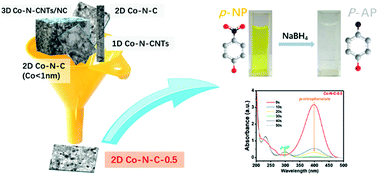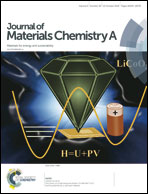Structure-, dimension-, and particle size-engineering toward highly efficient supported nanoparticulate metal catalysts†
Abstract
High-performance nitrogen-doped carbon-supported nanoparticulate transition-metal catalysts (M–N–C-X) are urgently desired in a diverse range of application fields for their very low-cost and abundant reserves compared with precious-metal-based catalysts. However, a general and simple method that can simultaneously manipulate the morphology of the carbon support material and the particle size of supported metal nanoparticles is still a formidable challenge. In this context, we report a versatile and simple approach for the synthesis of M–N–C–X via the utilization of metal (Fe and Co)–phenolic (tannic acid) complexes and dicyandiamide as renewable feedstocks. Specifically, by simply manipulating the addition content of the metal precursor, one-dimensional (1D) metal nanoparticles encapsulated in nitrogen-doped carbon nanotubes (M–N–CNTs), two-dimensional (2D) hierarchically porous nitrogen-doped carbon-supported metal nanoparticles (2D-M–N–C), and three-dimensional (3D) metal nanoparticles encapsulated in nitrogen-doped carbon nanotubes in situ grown on hierarchically porous carbon sheets (M–N–CNTs/NC) can be synthesized, along with the variation of the metal particle size from dozens of nanometers to sub-nanometers. By utilizing the chemical conversion of p-nitrophenol to p-aminophenol in a NaBH4 aqueous solution as a model reaction system, Co–N–C-0.5 showed the highest catalytic performance, with a mass-normalized rate constant of 578 min−1 g −1L. Such a performance was achieved because the 2D hierarchically porous carbon sheets provided sufficient active sites and fast mass transportation, and the particle size and exposed content of cobalt nanoparticles were balanced. Owing to the outstanding chelating and complexing ability of tannic acid, this method is potentially amenable to obtain M–N–C-X by using other metal precursors. This synthetic methodology can provide inspiration for further development of high performance supported metal catalysts.



 Please wait while we load your content...
Please wait while we load your content...